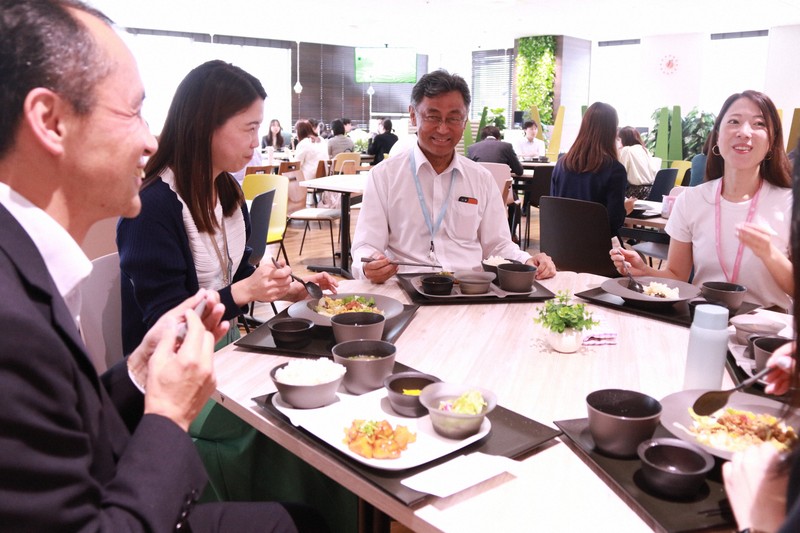
The Changing Landscape of Workplace Dining in Japan
In Tokyo, the rising costs of rice and other essential foods are putting pressure on household budgets, making lunch an important consideration for many working professionals. As traditional in-house company cafeterias become less common, new models of workplace dining are emerging to meet the needs of employees.
A New Approach to Workplace Meals
At a combined cafe and cafeteria located on the fifth floor of The Tokyo Star Bank Ltd headquarters in Minato Ward, employees can choose from a variety of meals each day. Options include sweet-and-sour pork with side dishes, taco rice, curry with beef tendon, and soba noodles with tempura. The menu is designed to be both appealing and nutritious, offering a range of choices that cater to different tastes and dietary needs.
This cafeteria opened this spring after previous attempts at providing boxed lunches were not well received due to limited variety and a fixed menu. Additionally, nearby restaurants were often expensive, especially in affluent areas. To address these issues, the bank opted for a "kitchenless cafeteria" model, which requires only a power source and a table for serving meals.
Jiro Narukawa, head of the company's general affairs department, explained that the building’s structure did not allow for gas or oil use, and there were restrictions on wastewater drainage. This led to the decision to implement a catering-based solution.
The menu is created by chefs and nutritionists, ensuring both flavor and nutritional balance. After a tasting event, the bank partnered with Nonpi Inc., a catering company specializing in kitchenless cafeterias. Nonpi now supplies around 200 meals daily, priced at approximately 500 yen (around $3.45), which is significantly cheaper than nearby restaurant options.
Kanae Ezaki, a 33-year-old employee, praised the service, saying she no longer needs to bring homemade bento lunches. “With rice becoming more expensive and the effort required to cook and bring my own meals, I’m really grateful to have so many menus that I like,” she said.
Addressing Communication Challenges
The kitchenless cafeteria model also helps foster communication among employees, particularly after the rise in remote work during the pandemic. These shared spaces encourage interaction and help build a sense of community within the workplace.
Decline of Traditional Cafeterias
Traditional company cafeterias, which require onsite kitchens and dishwashing facilities, are becoming less common due to high maintenance costs and operational challenges. According to data from the health, labor, and welfare ministry, the number of workplace food service facilities peaked at 6,859 in fiscal 2003 but dropped to 4,930 by fiscal 2023.
In response to these challenges, companies are turning to alternative solutions such as the "third wage hike," which focuses on increasing disposable income through expanded benefits rather than salary increases. This includes providing affordable, high-quality lunches without the need for in-house kitchens.
Nonpi entered the corporate cafeteria market in 2018 and has seen increased demand since the reclassification of COVID-19 in May 2023. The company reports receiving more inquiries from potential clients than ever before.
Miyu Ishikawa, a public relations representative at Nonpi, noted that trends in workplace dining are evolving. “We’re seeing more interest in vegan cuisine and Halal options due to growing health consciousness and a more diverse workforce. We also plan to expand our menu to include more vegetables as they become more expensive.”
Expanding Benefits for Employees
Another approach to workplace dining is the Ticket Restaurant program, offered by Edenred Japan Co. This service allows employees to use IC cards loaded with electronic funds to subsidize their meal expenses at participating restaurants and convenience stores. Companies can contribute up to 7,000 yen per month, with both employer and employee sharing the cost equally.
Edenred Japan reported a significant increase in the number of companies adopting the system, with growth reaching around 7.3 times compared to 2021.
A survey by Recruit Co. found that the average cost of weekday lunches has risen to a record high of 485 yen ($3.32), with all categories—delivered meals, dining out, and homemade bentos—showing consistent price increases over the past five years.
The Role of Benefits in Job Hunting
Shunichiro Saga, an analyst at One Career Inc., believes that the decline in traditional company cafeterias will continue. He pointed out that more companies are focusing on benefits such as meal subsidies and boxed lunches rather than maintaining in-house kitchens.
Saga also emphasized that job seekers, including new graduates and mid-career professionals, are increasingly considering generous benefits when choosing employment opportunities. “Salary is important, but so are the perks that enhance quality of life,” he said.


Posting Komentar